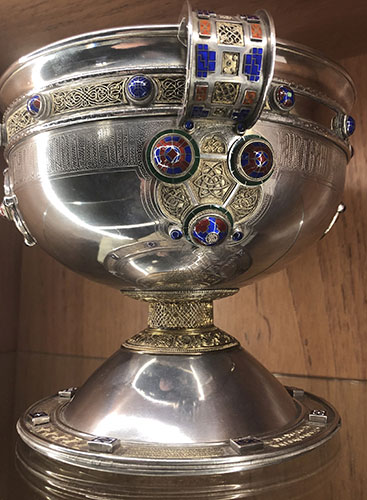 The Ardagh Chalice is a superb and ornate example of early medieval Irish liturgical metalwork, dating from around the 9th century.
The Ardagh Chalice is a superb and ornate example of early medieval Irish liturgical metalwork, dating from around the 9th century.
The chalice is part of the ‘Ardagh Hoard’ found in 1868 by two boys digging in a potato field near the village of Ardagh in county Limerick, Ireland. About 7 inches in height and 9 in diameter, and constructed with two handles (for the thumbs) to assist in holding it securely, it is an example of a ‘ministerial chalice’ used at Mass for the administration of holy communion under the form of wine to clerics and the laity.

As the liturgical scholar Joseph Jungmann sj points out[i], by the seventh century the practice in Rome and elsewhere was for the faithful to receive holy communion from a large ‘ministerial’ chalice, as distinct from the ‘sacrificial’ chalice in which the celebrating priest actually consecrated the wine. To provide for the communion of the faithful, by at least the seventh century the ministerial chalice would be part filled with a large measure of unconsecrated wine, into which a smaller amount of the consecrated precious Blood would be poured from the sacrificial chalice. In this way the whole larger chalice was consecrated. The Ardagh Chalice is believed to be an example of such a ministerial chalice.
The main part of the chalice is made of silver and gilt bronze, and is adorned with remarkable enamels, filigree and engraving. Celtic spiral and interlacing patterns feature, and the names of the twelve apostles are engraved in Latin around the large hemispherical cup. The Ardagh Chalice is displayed in the Irish national museum in Dublin.
It was following a visit to Dublin at the beginning of the 20th century that the third Archbishop of Sydney, Cardinal Moran, received an exquisitely made replica of it as a gift from the Dominican Sisters at Cabra, Dublin. This full scale replica, in silver, gilt metal and cloisonné enamel, bearing marks for E Johnstone Ltd, Dublin, 1903, is now at St Mary’s Cathedral, Sydney.

The replica Ardagh Chalice was part of the cardinal’s collection of items of Irish archeological interest which included a replica of other finds such as the Tara Brooch and the Shrine of St Patrick’s Bell. In due course the replica chalice, which was not itself capable of liturgical use, came to be in the collection of artifacts at St Patrick’s College, Manly, the seminary founded by Moran.
In the mid 1980s (a period when the present writer was a student at St Patrick’s College), the seminary authorities decided to put the replica chalice to actual liturgical use by having a watertight bowl of gilt metal inserted into the replica chalice. The rim of this bowl extended over the historical rim of the chalice and was fashioned with two pouring lips. This configuration was not suitable for drinking directly from the chalice, but was intended to express, literally, one cup for the Eucharist, at least at its offering.
The chalice was then used at Masses in the seminary chapel in such a way that, at the Preparation of the Gifts, it would be filled with wine to be consecrated and would be the only chalice on the altar during the Eucharistic Prayer. Then, after the Eucharistic Prayer at the time of the faction rite of the consecrated Bread, the Blood of Christ in the replica Ardagh Chalice would be poured from it into several usual chalices for the communion of the clergy and people.

Ironically, then, the original use of the Ardagh Chalice as a vessel INTO WHICH the consecrated wine was poured, was completely reversed in the new use of the replica Ardagh Chalice which had become a vessel FROM WHICH the consecrated wine was poured.
The practice of decanting the consecrated wine from one vessel to another was not without controversy. In 2004 the Congregation for Divine Worship and the Discipline of the Sacraments directed that The pouring of the Blood of Christ after the consecration from one vessel to another is to be completely avoided, lest anything happen that would be to the detriment of so great a mystery (Redemptionis sacramentum 107).
Following the closure of St Patrick’s College, Manly, in 1995, Cardinal Moran’s replica of the Ardagh Chalice came to St Mary’s Cathedral, Sydney. At some point the gilt metal bowl inserted into it in the 1980s was removed. This has returned the replica to its original and authentic configuration while revealing the original dedicatory inscription To his Eminence Patrick Francis Moran, Archbishop of Sydney, from the Sisters of the Dominican Convent, St Mary’s, Cabra, Dublin, Ireland, as a small token of their undying gratitude for a most signal benefit.
Very Rev DON RICHARDSON is Dean of St Mary’s Cathedral in Sydney and Director of the Liturgy Office.
[i] Jungmann, Joseph sj, The Mass of the Roman Rite, Vol. II, Notre Dame, Christian Classics, 2012. Pp 382-383.
